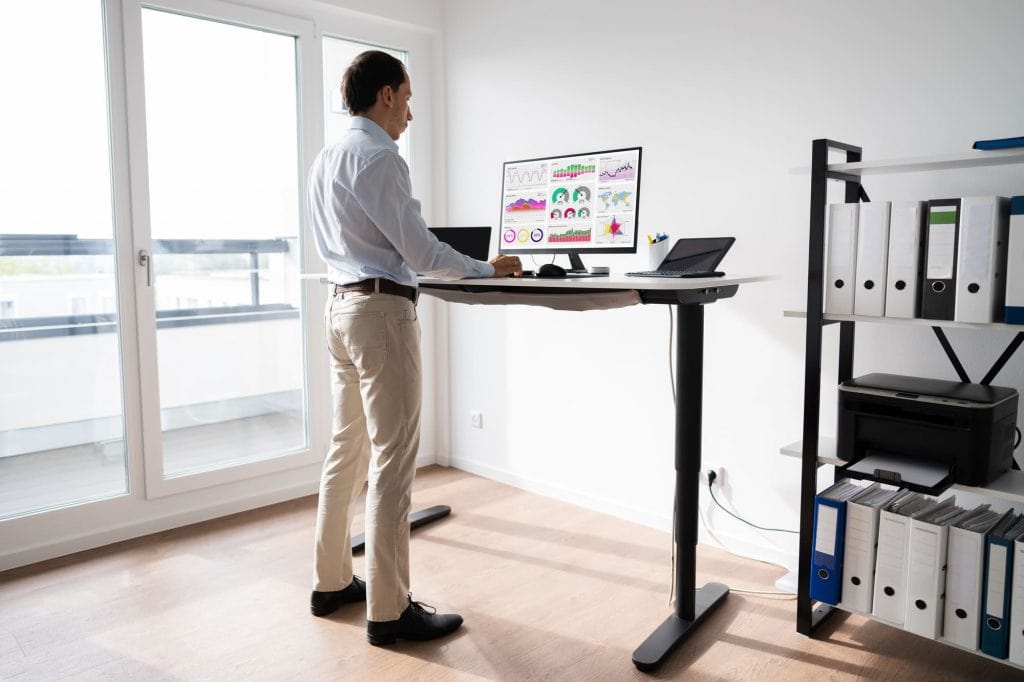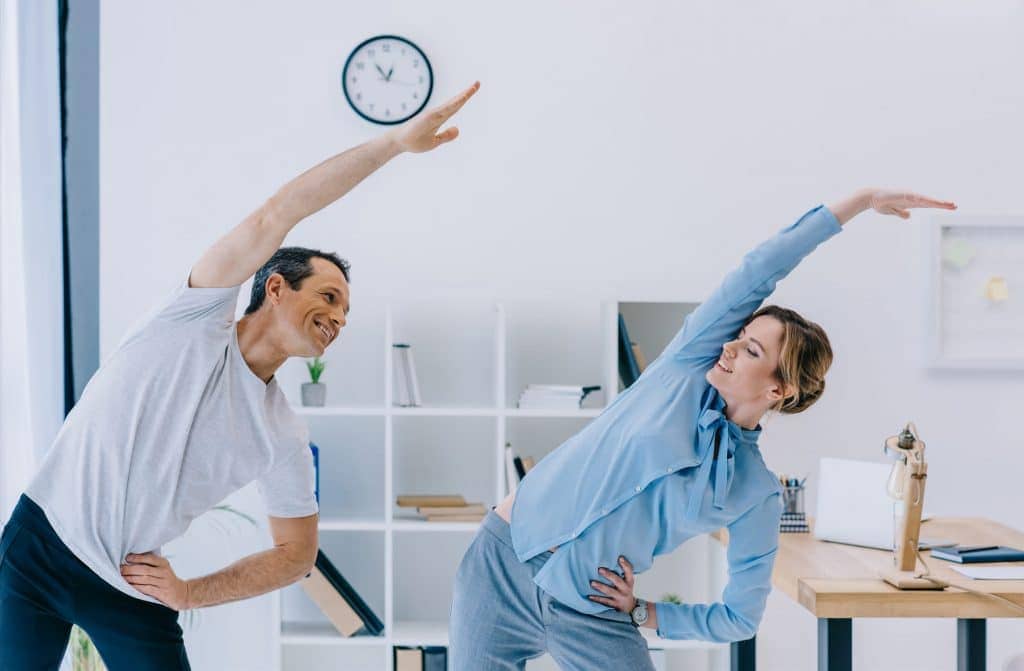*When you buy through links on our site, we may earn an affiliate commission at no additional cost to you.
Working on your computer all day can leave you no time for the gym. If you have a standing desk, however, it can help you get off your butt and cut down on the sedentary lifestyle.
But then again, your standing desk shouldn’t count as a replacement for exercises. Remember, standing burns only a few calories compared to walking and workouts.
Too much standing will also leave you with hurting feet and make you feel fatigued quickly. Experts recommend taking regular breaks from your stand-up desk to walk or do stretching exercises.
This guide will take you through 13 easy-to-implement standing desk exercises you can do at your standing desk. The exercises require no expensive exercise equipment or leaving your office.
Table of Contents
13 simple standing desk workout exercises
The stand-up desk exercises discussed below are pretty simple, and anybody, including beginners, can do them with ease. They’ll work different parts throughout the day and keep your body from getting stiff.
Let’s get a closer look at these workouts…
1. Standing hip flexor / thigh stretch
Hip flexors play a critical role in your lower body movement. Located near the top of your thighs, this group of muscles enables you to walk, bend, kick, and even swivel your hips.
If your hip flexors become too tight, they can tear easily and make you feel pain.

This is how to stretch your hip flexors to keep them loosened up:
- Stand with your feet about the width of hips and the toes facing forward
- Bend the right knee and then bring the right heel up towards the butt
- Now hold the right foot using your right hand and gently pull so that the knee points toward the floor
- You may use your left hand to hold on to a counter or chair for balance
- Hold this position for 30 seconds and then switch to the other leg
2. Stretch Squat
Squats are a common exercise that you can do in various workouts and basically on any occasion.
Squats also have many benefits. For instance, they can help burn more calories and help with excess weight loss.
They can also lower your chances of getting knee and ankle injuries by helping take pressure off these areas.
Squats will strengthen your bones, tendons, and even ligaments around the leg muscles when done properly.

Here’s how you do sit-stand desk squats:
- Stand with shoulder-width apart stance
- Slowly bend your knees, and at the same time, push your butt backward.
- Get down as far as your mobility lets you, and take your time
- Always make sure your whole foot stays on the ground, don’t lift your heels
- Perform 12-15 squats and rest
- Repeat this exercise up to 3 times for the best effect.
3. Calf raises in the standing position
Standing calf raises are another popular exercise for office workers. It helps promote ankle mobility and stability. It involves targeting the muscles at the back of your lower legs (specifically the gastrocnemius and soleus muscles).

The process for doing calf raises is pretty simple, as outlined below:
- Raise your heels a few inches off the ground
- Hold this position for 30 seconds and then return to the starting position
- Do the calf raises for both legs simultaneously
- Be sure to hold onto your standing desk with your hands for support
4. Standing calf stretch
Your calf muscles are responsible for many daily functions, including walking and standing. This means these muscles can easily get tired or stiff.
Calf stretches aim to activate these muscles. If done correctly, they can help increase blood flow to the area and thus reduce tightness and calf pain.
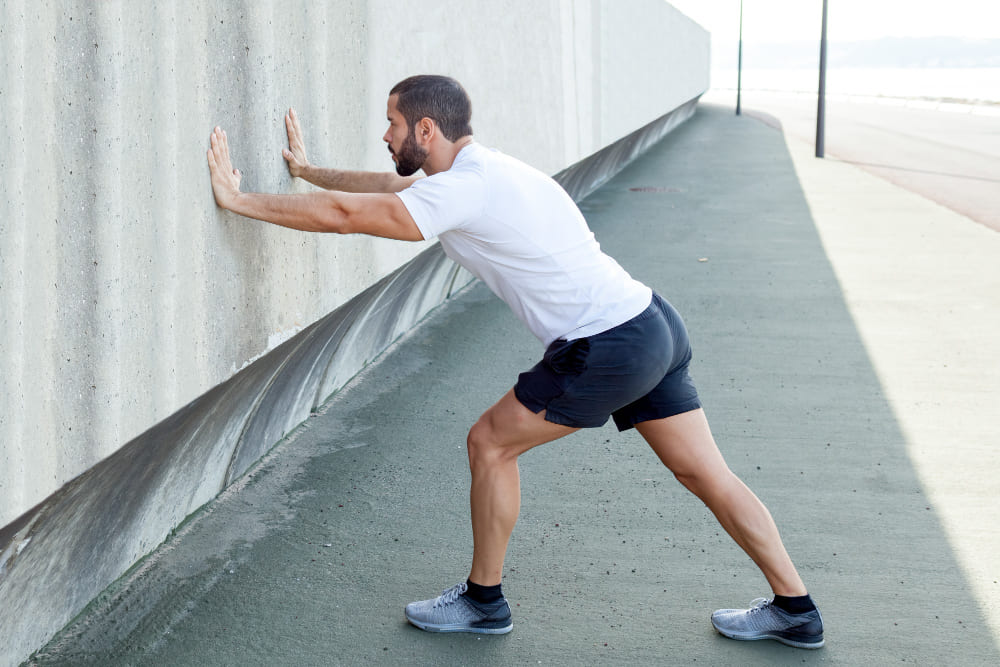
Follow these steps to stretch your calf muscles correctly:
- Position yourself closer to one leg of your sit-stand desk
- Lift the ball of your right foot off the ground and position it against the leg (ensure you keep your heel firm on the floor)
- Lean the body into the desk and feel your calf stretch
- Hold this position for 20-30 seconds and repeat
- Switch to the other leg and repeat the above steps
5. Standing with one leg exercise
As you can easily picture, standing with one leg is a simple exercise that everyone can do. It goes a long way in improving your balance, which can help prevent falls that can lead to serious injuries.
If you want a boost in balance to work on your sit-stand desk for long hours, consider this exercise.

Steps to follow:
- You’ll need to position yourself next to your height adjustable desk for support
- Hold on to the desk with both hands
- Slowly lift one of your legs off the ground
- While in this position, try to maintain your balance for about 5 seconds
- Return the raised feet to the starting position and repeat the whole process again
- Try increasing the time spent on the legs with the repeat sessions
- Switch legs and repeat the entire process
6. Standing chest stretch
Sitting in front of your computer for long periods of time is one of the major culprits of tight chest muscles.
Unfortunately, a tight chest can lead to a limited range of motion and even affect your posture.
Good chest stretches will help open up this area, increasing the chest muscles’ flexibility and increasing the range of motion in your shoulders.
This will improve your posture and ensure pain-free movement patterns when using your standing desk.
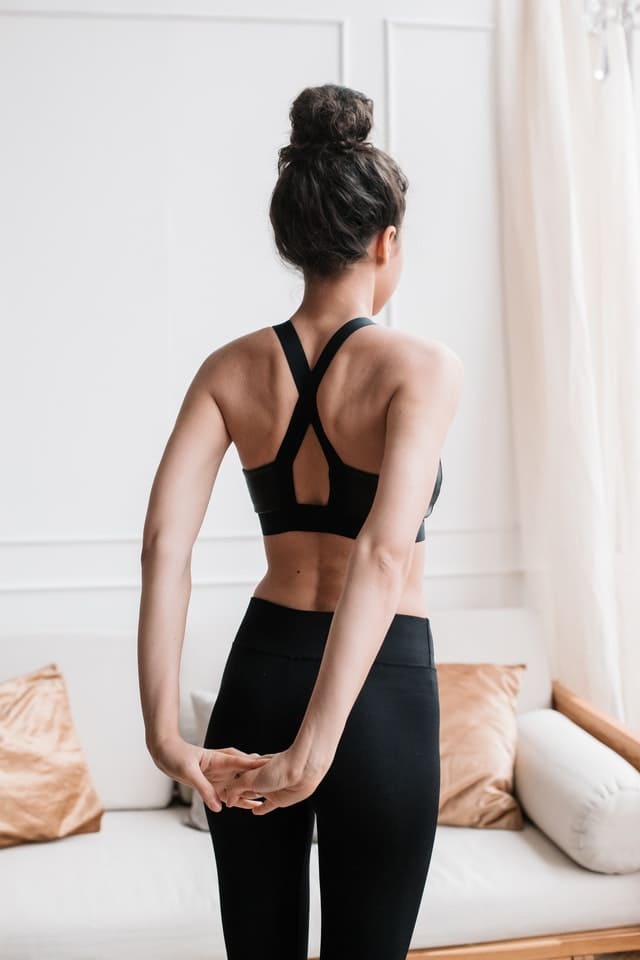
This is how you correctly stretch your chest:
- Stand tall with the feet about shoulder-width apart
- Interlace the fingers behind your back and then straighten your arms
- As your chest remains lifted, pull the shoulder blades downward
- Hold this position for 15 to 20 seconds
- Repeat this stretch 3 times.
7. Standing desk pushups
Pushups remain the core of most workouts, and they’re helpful for your upper body and hands. However, a pushup in the office may be unpleasant since the floor is dirty.
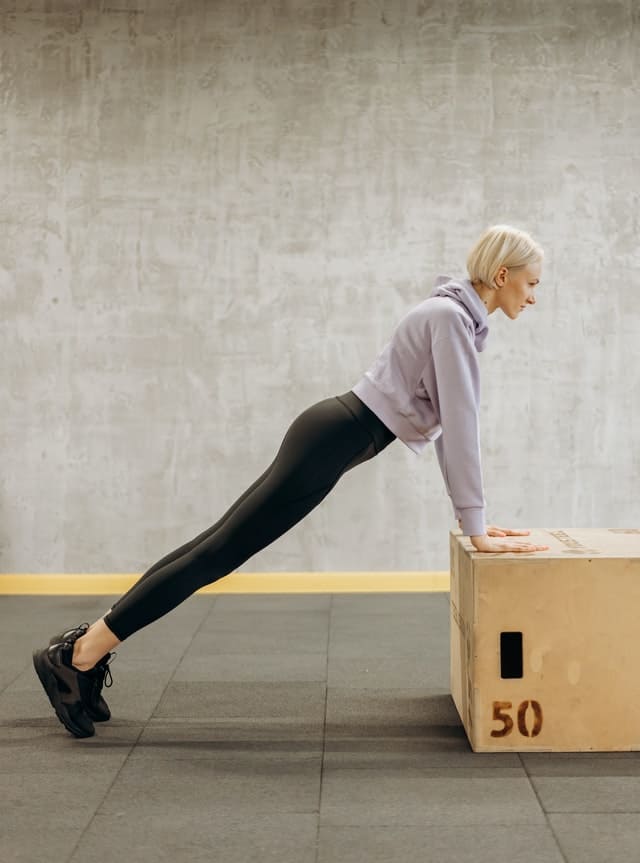
A good way to do this workout is by using your sit-stand desk, as we have explained below.
- Hold onto your standing desk and then assume the same position you’d take when doping pushups on the floor
- Go ahead and do the pushups as you normally would.
The main difference here is that you’re not completely horizontally aligned when you hit the floor for pushups.
8. Gluteal squeeze
If you share your workspace with other people and want an exercise that you don’t do in your office without drawing the attention of fellow workers, this is it.
Gluteal squeeze is a quick and easy standing desk exercise that you can do just anywhere. It is all about squeezing your glutes. In so doing, you improve your endurance, power, and strength as per this study published in the Journal of Life and Environmental Sciences.
Doing this exercise every day is also sure to keep away injury.
- How to gluteal squeeze:
- Contract/tighten your butt muscles and hold it for about 3 seconds
- Release and relax for 2-3 seconds and do it again
- For the best results, we advise you to repeat this simple exercise several times during your workday
9. Standing hamstring Curls
Hamstring curl exercise, also known as leg curl, helps strengthen your hamstrings, thus improving your stability and leg muscle strength.
With stronger hamstrings, you’re less likely to experience injuries and pain. It’s also simple to do as it involves bending your knees and then moving the heels toward your butts as the rest of your body stays still.

Follow these steps to correctly do hamstring stretch while standing:
- Stand with the feet hip-width apart
- Place your hands on a chair or around your waist for balance
- Shift your weight onto the left leg
- Slowly bend the right knee as you pull the heel towards your butt. Make sure the thighs stay parallel
- Slowly lower your foot
- Do 12-15 reps and switch legs and repeat the steps
10. Shoulder stretch
Poor posture, sitting for prolonged periods of time, and using a computer that’s not well-positioned are some of the main causes of stiff shoulders.
Your shoulders getting tight can not only limit your range of motion but also cause discomfort. If left unchecked, this tightness can cause neck pains and tension headaches.
The good thing is that doing shoulder stretches regularly can help ease muscle tension, tightness, and pain around your neck and shoulders.

Try this shoulder stretch to prevent the tightness in your shoulders:
- Stand with the feet about hip-width apart
- Stretch out your right arm straight
- Bring the right arm across your body such that the hand points to the floor on the other side of your left leg
- Bend your left arm at the elbow
- Hook your left forearm under your right arm so that the right arm gets supported above the elbow
- Now employ your left forearm to pull the right arm further in and across your body. You should be able to feel a stretch on the back of your right shoulder
- Hold this position for 20 to 30 seconds
- Repeat the stretch on the other side
11. Leg extensions
This is another great standing desk exercise to prevent stiffness. This stretch will work out your leg, core, and back when done correctly. If that’s too easy for you, add a rubberband like in the picture below.
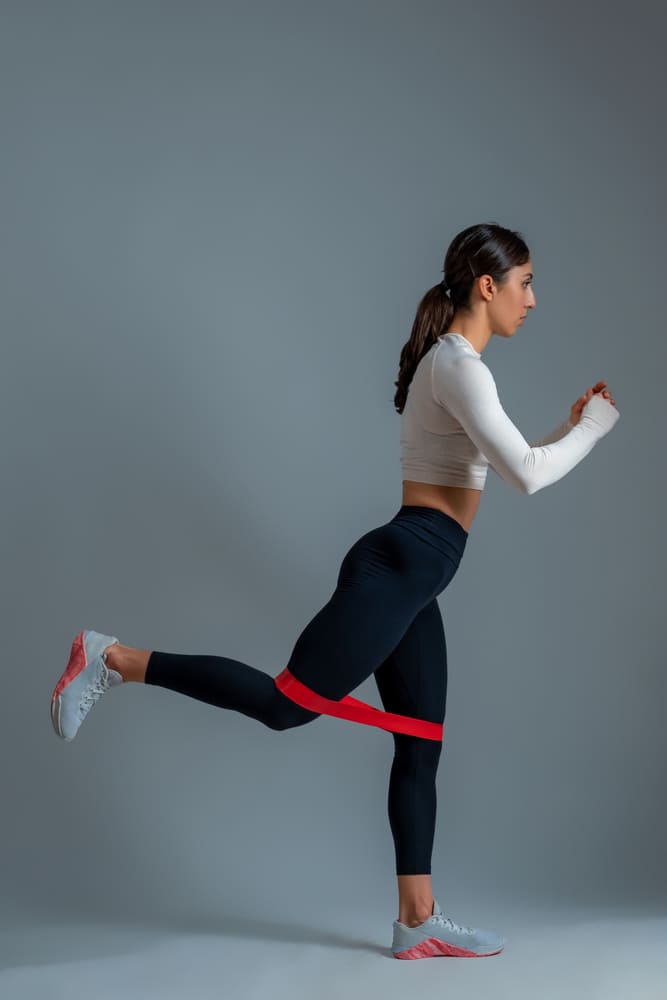
This is how you do it:
- Start by engaging your core to prevent your back from too much arching.
- Place your hips around your hips for balance and support
- Extend your right leg straight behind you. This movement should promote glute movement as well
- Hold the position for approx. 5 seconds and then bring the leg back to the center, then switch legs
- Do 12-15 reps for each leg
12. Back stretch
Using a standing desk doesn’t mean that you can’t slouch. As you continue using this desk, you’ll find yourself leaning to one side or leaning forward onto your hands to check the screen.
While this may not be as damaging as the C slouch we tend to make while sitting, the bad posture can still have an impact. Luckily, all you need is a good back stretch to help ease the tension and strengthen your spine.

Here’s how to perform a good back stretch:
- Look at the ceiling while arching your back enough to feel the stretch
- You may consider placing your hands on your hips or the bottom of your back for balance and stability
- Hold this position for 5 to 15 seconds
- Repeat this process 5-8 times to get maximum benefits
13. Hand Stretches
You probably work your wrists and hands too much while working on tasks such as typing. These repetitive motions easily create stiffness and weakness in your fingers and wrists.
For this reason, your hands also deserve to be exercised to help prevent injuries, keep them flexible, and keep off conditions like carpus tunnel syndrome.
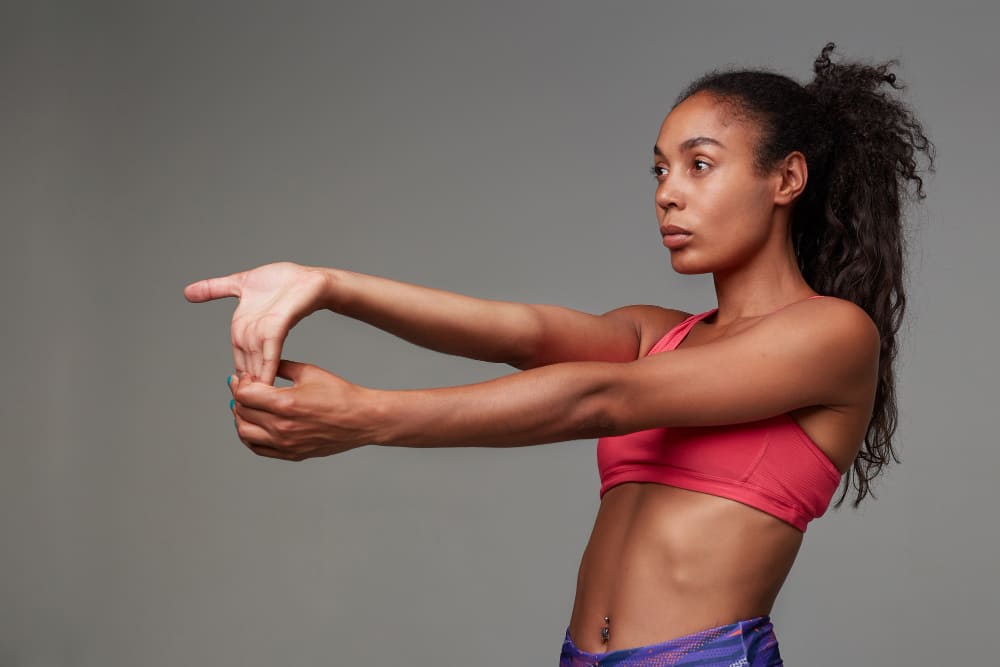
This is how you do a simple hand stretch:
- Place your hands on the desk while facing down and the fingers facing toward you (i.e., in a backward manner compared to normal hand positioning)
- For a more challenging stretch, try slightly leaning forward
- Hold this position until you feel the tension being released
The Bottom Line – Standing Desk Exercises
Working all day in your office should never be an excuse to not exercise. With the simple standing desk exercises we have discussed in this guide, you can still keep fit while working on your computer.
These exercises are simple, and everyone can do them without leaving the comfort of their home office or workspace.
We recommend doing a combination of these exercises that target different body parts every day. This way, you can stay assured that you’ll remain in good shape. And your workdays will be more energized with good moods and increased productivity.
Above all, remember that standing desks will never be a replacement for exercises. No matter how many hours you use your sit-stand desk, always find time to do a handful of the stretches we have discussed above.

